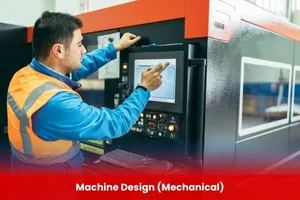Machine Design (Mechanical)
At BURAAQ UK, the Machine Design (Mechanical) course is structured to provide a deep and practical understanding of how mechanical components and systems are designed, analyzed, and optimized to meet real-world engineering challenges.This course focuses on the fundamentals of designing mechanical parts such as shafts, gears, bearings, fasteners, couplings, and more—ensuring learners gain a solid foundation in applying engineering principles, material selection, and failure analysis in machine design.

Aim of Machine Design (Mechanical)
The aim of the Machine Design (Mechanical) course at BURAAQ UK is to develop learners’ ability to design, analyze, and validate mechanical components and systems using engineering principles, material science, and modern design tools—preparing them to create efficient, durable, and safe mechanical solutions for real-world industrial applications.
Course Overview
Machine Design (Mechanical)
- Educational Background
- Minimum Requirement:
- Completion of Intermediate / A-Levels / Matric with Technical Background
- Preferred Qualifications:
- Diploma (DAE) in:
- Mechanical Engineering
- Mechatronics
- Automotive or Manufacturing Technology
- Bachelor’s Degree (BSc / BEng / BTech) in Mechanical or related engineering disciplines
- Diploma (DAE) in:
- Technical Skills (Preferred)
- Basic knowledge of:
- Mechanics and strength of materials
- Engineering drawing and drafting
- Mathematics and physics relevant to mechanical systems
- Familiarity with CAD software is an advantage, but not mandatory
- Suitable For
- Engineering students and graduates
- Technicians and apprentices in mechanical or manufacturing sectors
- Maintenance or design professionals seeking to upskill
- Individuals preparing for careers in mechanical design or product enginee
| Course Code | Curriculum Title | Credit | DLH |
|---|---|---|---|
| BUK1390-1 | Introduction to Machine Design | 3 | 15 |
| BUK1390-2 | Engineering Materials & Selection | 3 | 15 |
| BUK1390-3 | Stress Analysis & Failure Theories | 3 | 15 |
| BUK1390-4 | Design of Machine Elements | 3 | 15 |
| BUK1390-5 | Gears and Gear Trains | 3 | 15 |
| BUK1390-6 | CAD Integration in Machine Design | 3 | 15 |
Module 1: Introduction to Machine Design
- Scope and importance of machine design in industry
- Types of mechanical systems and components
- Design process: from concept to manufacturing
- Safety, reliability, and design ethics
Module 2: Engineering Materials & Selection
- Properties of engineering materials (metals, polymers, composites)
- Stress-strain behavior and material selection for mechanical parts
- Fatigue, creep, and wear considerations
- Cost and manufacturability factors in material choice
Module 3: Stress Analysis & Failure Theories
- Types of stresses (tensile, compressive, shear, bending, torsion)
- Factor of safety and allowable stress
- Theories of failure: Maximum Stress, Von Mises, Mohr’s Circle
- Stress concentration and fatigue design
Module 4: Design of Machine Elements – Part 1
- Shafts and Keys
- Couplings (rigid and flexible)
- Bolts, Screws, and Threaded Fasteners
- Welded and Riveted Joints
Module 5: Design of Machine Elements – Part 2
- Springs (helical, leaf, torsion)
- Bearings (sliding and rolling contact)
- Brakes and Clutches
- Power Screws and Joints
Module 6: Gears and Gear Trains
- Types of gears: spur, helical, bevel, worm
- Gear terminology and design calculations
- Gear force analysis and material selection
- Design of gear trains for speed and torque transmission
Module 7: Design for Manufacturing & Assembly (DFMA)
- Principles of DFMA
- Tolerances, fits, and surface finishes
- Standardization and modular design
- Use of design handbooks and international standards (e.g., ASME, ISO)
Module 8: CAD Integration in Machine Design
- Introduction to 3D modeling of machine parts
- Use of CAD software (SolidWorks, Fusion 360, or AutoCAD Mechanical)
- Assembly modeling and interference checking
- Drawing generation and BOM creation
Module 9: Final Design Project
- Real-world design challenge: concept to CAD model
- Load analysis, material selection, and full documentation
- Presentation of design solution with technical justification
- Students Diploma (DAE)
- Technicians & Apprentices
- Industry Professionals
- Career Switchers & Enthusiasts
- International Learners
- All Modules within this qualification are assessed internally by the approved training Centre and externally verified by BURRAQ UK. The program uses a criterion-referenced assessment approach to ensure that learners successfully meet all required learning outcomes.
- A Pass in any unit is granted only when the learner submits valid, reliable, and authentic evidence that demonstrates achievement of the assessment criteria. The Assessor is responsible for reviewing this evidence and confirming that the learner has attained the expected standard.
